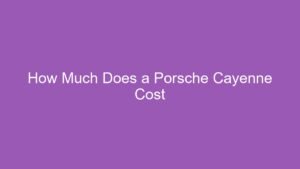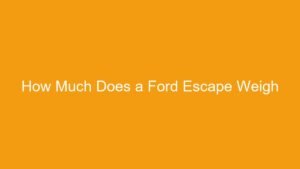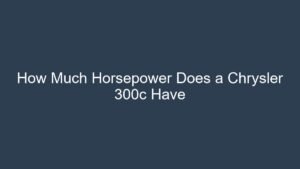
Contents
- How Much Is a New Range Rover? Your Ultimate Guide to Understanding the Price Tag
- The Big Question: What’s the Starting Price of a New Range Rover?
- Factors That Significantly Influence a New Range Rover’s Price
- Your Step-by-Step Guide to Determining Your Range Rover Price
- Beyond the Sticker Price: Total Cost of Range Rover Ownership
- Smart Buyer Tips for Your New Range Rover Purchase
- Common Mistakes to Avoid When Buying a New Range Rover
- Conclusion
- FAQ
How Much Is a New Range Rover? Your Ultimate Guide to Understanding the Price Tag
The iconic Range Rover – a name synonymous with luxury, capability, and undeniable presence. If you’ve been dreaming of owning one of these magnificent vehicles, one of the first questions that likely comes to mind is, “How much does a new Range Rover cost?”
It’s a fantastic question, and one without a single, simple answer. A new Range Rover isn’t a one-size-fits-all purchase, and its price can vary significantly based on a multitude of factors. But don’t worry, we’re here to help you navigate the world of Range Rover pricing with a friendly, detailed guide.
Let’s break down everything you need to know, from starting prices to the often-overlooked costs of ownership.
🛒 Recommended Product
The Big Question: What’s the Starting Price of a New Range Rover?
While there’s no single, fixed number, you can expect a new Range Rover to typically start from around $100,000 for its entry-level models and can easily climb well past $200,000+ for higher trims and loaded options. This wide range reflects the vast array of choices, engines, and luxurious features available.
It’s crucial to understand that this is just a starting point. The final price you pay will depend on your specific configuration.
Factors That Significantly Influence a New Range Rover’s Price
Think of the Range Rover as a blank canvas; the more sophisticated the paint, the more intricate the details, and the more powerful the engine you choose, the higher the final price will be. Here are the key elements that contribute to the cost:
-
Model and Trim Levels:
- Range Rover offers various “families” and within each family, several trim levels. These trims represent different tiers of luxury, performance, and standard features.
- Typically, you’ll find a progression from a “base” or “standard” model up to more opulent versions like the Autobiography, and then to the ultra-exclusive SV models. Each step up in trim level brings a substantial increase in price. Higher trims often include more powerful engines, premium interior materials, advanced technology, and distinctive exterior styling as standard.
-
Engine Options:
- You’ll likely have a choice of powertrains, ranging from efficient mild-hybrid (MHEV) options to powerful plug-in hybrids (PHEV) and robust V8 engines.
- More powerful or advanced engine options (like the P550e PHEV or the V8 models) will add a premium to the base price.
-
Optional Features and Packages:
- This is where personalization truly comes into play. Range Rover offers an extensive list of optional features and packages. These can include:
- Technology Upgrades: Advanced infotainment systems, head-up displays, enhanced driver-assistance features.
- Luxury Enhancements: Upgraded leather, massaging seats, premium sound systems, rear-seat entertainment.
- Capability Boosts: Advanced off-road systems, specialized towing packages.
- Convenience Items: Power-deployable side steps, refrigerator compartments.
- Each option or package you add will increase the total price of the vehicle. These can quickly add tens of thousands of dollars to the final cost.
- This is where personalization truly comes into play. Range Rover offers an extensive list of optional features and packages. These can include:
-
Customization Choices:
- Beyond specific options, you can often customize details like exterior paint color (special metallic or satin finishes cost extra), wheel designs and sizes, interior veneer finishes, and headliner materials.
- Unique or exclusive customization choices will naturally come with a higher price tag.
-
Destination and Delivery Charge:
- This is a mandatory fee charged by the manufacturer to transport the vehicle from the factory to the dealership. It’s non-negotiable and typically adds around $1,400 to $1,800 to the total.
-
Taxes, Registration, and Dealer Fees:
- Sales tax is applied based on your state’s regulations and the vehicle’s selling price.
- Registration and licensing fees vary by state and locale.
- Dealerships also typically charge various administrative fees, documentation fees, and sometimes, for luxury vehicles, “market adjustments” if demand is high. Always ask for a clear breakdown of all dealer fees.
Your Step-by-Step Guide to Determining Your Range Rover Price
Ready to get a more precise idea of what your dream Range Rover will cost? Follow these steps:
Step 1: Explore the Current Range Rover Lineup and Trim Levels.
* Start by visiting the official Land Rover website. Familiarize yourself with the different Range Rover models (the main Range Rover, Range Rover Sport, Range Rover Evoque, Range Rover Velar – ensure you’re looking at the primary “Range Rover” model for this article’s focus).
* Identify the trim levels available for the specific Range Rover model you are interested in. These are usually listed with their starting MSRPs. This gives you your initial baseline.
🛒 Recommended Product
Step 2: Dive into the Online Configurator.
* The Land Rover website features an excellent “Build Your Own” or “Configurator” tool. This is your most powerful resource.
* Select your desired model and trim level. Then, you can meticulously choose your engine, exterior color, wheels, interior finishes, and all the individual options and packages you desire.
* As you add or remove features, the estimated total price will update in real-time. This allows you to experiment and see how each choice impacts the bottom line.
Step 3: Note the Standard Features vs. Optional Extras.
* Pay close attention to what comes standard with your chosen trim versus what is an additional cost. Sometimes a feature you assume is standard on a luxury vehicle might be an expensive add-on.
Step 4: Account for Destination, Taxes, and Fees.
* Remember to factor in the destination charge (which the configurator usually adds automatically).
* For sales tax, you’ll need to use your state’s sales tax rate applied to the vehicle’s selling price. You can usually find a tax calculator online for your specific location.
* Budget an additional few hundred to over a thousand dollars for registration, title, and potential dealer documentation fees.
Step 5: Contact Multiple Dealerships for Quotes.
* Once you have a general idea of your desired configuration, reach out to at least 2-3 different Land Rover dealerships.
* Provide them with your exact build specifications. Ask for an “out-the-door” price quote that includes all fees, taxes, and any potential market adjustments. This helps ensure transparency.
* Dealerships might have different availability, incentives, or markups, so comparing quotes is crucial.
Step 6: Understand Your Financing or Leasing Options.
* If you’re not paying cash, the total cost of ownership will also involve interest payments (for financing) or lease payments.
* Research current interest rates for car loans or lease programs offered by Land Rover Financial Services and external lenders. Your credit score will play a significant role here.
* Don’t just look at the monthly payment; understand the total amount you’ll pay over the life of the loan or lease term.
Beyond the Sticker Price: Total Cost of Range Rover Ownership
Buying a new Range Rover is a significant investment, but the initial purchase price is only part of the financial picture. To truly understand how much a new Range Rover costs, you need to consider the Total Cost of Ownership (TCO).
-
Insurance:
- As a high-value, luxury vehicle, Range Rover insurance premiums are generally higher than those for more mainstream cars. Factors like your driving record, location, and the specific model/trim will influence this.
- Always get an insurance quote before finalizing your purchase.
-
Maintenance and Repairs:
- Luxury vehicles, especially those with advanced technology and sophisticated engineering, typically have higher maintenance costs. This includes routine service, parts, and specialized labor.
- Consider purchasing a pre-paid maintenance plan if available, as it can sometimes offer savings over paying for services individually.
-
Fuel:
- Many Range Rover models recommend or require premium fuel. Given their size and power, fuel consumption can be higher, especially for V8 models.
- If you choose a Plug-in Hybrid (PHEV), consider the cost of electricity for charging.
-
Depreciation:
- Like all new vehicles, a Range Rover will depreciate in value the moment you drive it off the lot. While Range Rovers tend to hold their value better than some other luxury brands, it’s still a significant factor in TCO.
- Higher-end luxury vehicles often experience steeper initial depreciation.
Smart Buyer Tips for Your New Range Rover Purchase
- Be Patient and Thorough: Don’t rush into a purchase. Take your time to research, configure, and compare.
- Research Thoroughly Online: The manufacturer’s website and reputable automotive review sites are invaluable resources for understanding features, specifications, and potential common issues.
- Test Drive Extensively: Drive the specific model and engine variant you are considering. Pay attention to comfort, handling, technology, and overall driving experience. Don’t be afraid to take it on different types of roads.
- Negotiate Confidently: While Range Rovers are luxury items, there can still be room for negotiation on the price, especially if you have competing quotes from other dealers. Negotiate the final price of the car first, before discussing trade-ins or financing.
- Understand Your Financing/Leasing Options: Know your budget and credit score. Shop around for the best interest rates if financing, or carefully analyze the terms of a lease agreement. Always understand the total cost, not just the monthly payment.
- Consider a Certified Pre-Owned (CPO) Range Rover: While this article focuses on new Range Rovers, if the price of a brand-new model is just out of reach, a CPO Range Rover can offer significant savings with the peace of mind of a factory-backed warranty and thorough inspection.
Common Mistakes to Avoid When Buying a New Range Rover
- Only Focusing on the MSRP: The manufacturer’s suggested retail price is just that – a suggestion. Your “out-the-door” price will be higher due to options, taxes, and fees.
- Ignoring the Total Cost of Ownership: Failing to budget for insurance, maintenance, fuel, and depreciation can lead to financial strain down the road. Always consider the long-term financial commitment.
- Not Comparing Dealerships: Different dealerships may offer varying prices, incentives, or even have different inventory. Shopping around can save you thousands.
- Rushing the Decision: Don’t let a salesperson pressure you into an immediate decision. A Range Rover is a major purchase; take your time.
- Falling for Unnecessary Add-ons: Be wary of high-pressure sales tactics for things like paint protection, extended warranties (unless thoroughly researched and justified), or other services that inflate the price without adding significant value to you.
Conclusion
Understanding how much a new Range Rover costs involves more than just looking up a single figure. It’s about recognizing the starting price, delving into the nuances of trim levels, engine choices, optional features, and the often-overlooked total cost of ownership.
🛒 Recommended Product
By following this detailed guide, utilizing online configurators, comparing dealer quotes, and being mindful of long-term expenses, you’ll be well-equipped to make an informed decision and drive away in your dream Range Rover with confidence. Happy shopping!
FAQ
Q. What is the starting price for a new Range Rover?
A. The starting MSRP (Manufacturer’s Suggested Retail Price) for a new, standard wheelbase Range Rover typically begins in the range of £100,000 to £110,000 in the UK, or approximately $108,000 to $115,000 in the US for the entry-level SE trim. This price can vary slightly depending on the specific market and model year.
Q. What factors significantly influence the final price of a new Range Rover?
A. Many factors contribute to the final price. These include the chosen trim level (e.g., SE, Autobiography, SV), engine option (mild-hybrid, plug-in hybrid, V8), wheelbase (standard or long wheelbase), optional features and packages (e.g., advanced driver-assist systems, premium sound systems, special paint finishes, interior upgrades), and dealer-added accessories or services.
Q. How much can the top-tier Range Rover models cost?
A. The most luxurious and high-performance Range Rover models, particularly the SV (Special Vehicle) trim, especially with a long wheelbase and extensive customization, can easily exceed £180,000 or $230,000. Fully optioned SV models with bespoke features and exclusive materials can push past the £200,000 or $250,000 mark.
Q. Do dealership fees and market adjustments add much to the MSRP?
A. Yes, in addition to the MSRP, you’ll typically encounter destination charges (for shipping the vehicle to the dealer), documentation fees, taxes, and registration costs. In high-demand periods or for popular models, some dealerships may also apply “market adjustments” or “additional dealer markup (ADM),” which can add several thousands to tens of thousands of dollars/pounds above the MSRP.
Q. Are there different engine options that affect the price significantly?
A. Absolutely. Range Rover offers various powertrains. The base mild-hybrid (MHEV) engines are generally the most affordable. Plug-in Hybrid (PHEV) models, offering electric-only range, command a higher price point. The most powerful V8 engines, often found in higher trims like the P530 or P615 SV, will significantly increase the overall cost due to their performance and complexity.
Q. What is the price difference between a standard and long-wheelbase (LWB) Range Rover?
A. Opting for the long-wheelbase version typically adds a premium over the standard wheelbase model. This increase is usually in the range of £5,000 to £10,000, or $6,000 to $10,000, depending on the trim level. The LWB provides increased rear legroom and often comes with enhanced rear seating options, justifying the extra cost.
Q. How much do optional features and packages typically add to the price?
A. Optional features and packages can substantially increase the final price. Individual options like specific wheel designs, advanced infotainment upgrades, premium Meridian sound systems, comfort packages (e.g., executive rear seating, massaging seats), or specialized exterior paint finishes can each add anywhere from a few hundred to several thousand dollars/pounds. A well-specified vehicle can easily accumulate tens of thousands in optional extras.
Related Articles
How Much Is a Corvette
How Much Does a Corvette Cost? Your Ultimate Guide to Unlocking the Dream Ah, the Corvette. Just uttering the name conjures images of sleek lines, exh…
How Much Is a Grand Wagoneer
How Much Is a Grand Wagoneer? Your Complete Guide to Understanding the Price Tag The Grand Wagoneer. Just the name conjures images of luxurious comfor…
How Much Is a Mclaren 720s
How Much Is a McLaren 720S? Your Ultimate Guide to Understanding the Price Tag The McLaren 720S. Just the name conjures images of blistering speed, ae…
Affiliate Disclosure: As an Amazon Associate, I earn from qualifying purchases made through links on this site.















